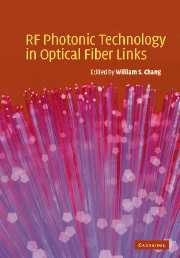Book contents
- Frontmatter
- Contents
- List of contributors
- Introduction and preface
- 1 Figures of merit and performance analysis of photonic microwave links
- 2 RF subcarrier links in local access networks
- 3 Analog modulation of semiconductor lasers
- 4 LiNbO3 external modulators and their use in high performance analog links
- 5 Broadband traveling wave modulators in LiNb03
- 6 Multiple quantum well electroabsorption modulators for RF photonic links
- 7 Polymer modulators for RF photonics
- 8 Photodiodes for high performance analog links
- 9 Opto-electronic oscillators
- 10 Photonic link techniques for microwave frequency conversion
- 11 Antenna-coupled millimeter-wave electro-optical modulators
- 12 System design and performance of wideband photonic phased array antennas
- Index
- References
6 - Multiple quantum well electroabsorption modulators for RF photonic links
Published online by Cambridge University Press: 06 July 2010
- Frontmatter
- Contents
- List of contributors
- Introduction and preface
- 1 Figures of merit and performance analysis of photonic microwave links
- 2 RF subcarrier links in local access networks
- 3 Analog modulation of semiconductor lasers
- 4 LiNbO3 external modulators and their use in high performance analog links
- 5 Broadband traveling wave modulators in LiNb03
- 6 Multiple quantum well electroabsorption modulators for RF photonic links
- 7 Polymer modulators for RF photonics
- 8 Photodiodes for high performance analog links
- 9 Opto-electronic oscillators
- 10 Photonic link techniques for microwave frequency conversion
- 11 Antenna-coupled millimeter-wave electro-optical modulators
- 12 System design and performance of wideband photonic phased array antennas
- Index
- References
Summary
Introduction
Performance of multiple quantum well (MQW) electroabsorption (EA) modulators can best be evaluated in terms of a basic RF photonic link. A basic RF photonic link consists of a laser transmitter with its optical intensity modulated by an RF signal, an optical fiber transmission line and a receiver. In the externally modulated link shown in Fig. 6.1, the RF source supplies the signal to the EA modulator. The CW laser radiation is coupled directly or through a pigtailed fiber to the modulator input. The fiber transmission line couples the modulated output to the receiver. The receiver detects the optical radiation and converts the intensity modulation back into RF power. Because of the low transmission loss of fibers, a major advantage of an RF photonic link is its low RF transmission loss, especially for long distances and at high RF frequencies. Many RF channels at widely different frequencies can also share the same optical carrier. More sophisticated links may employ optical or electronic amplification, distribute the modulated optical carrier in a fiber network, down or up convert the RF frequencies using opto-electronic components. However, the fundamental effect of a component such as a modulator can most clearly be understood through the basic link.
In Fig. 6.1, the optical carrier is obtained from CW laser and modulated by an external modulator, based on semiconductors or ferroelectrics such as LiNbO3 or polymers.
- Type
- Chapter
- Information
- RF Photonic Technology in Optical Fiber Links , pp. 165 - 202Publisher: Cambridge University PressPrint publication year: 2002
References
- 8
- Cited by



